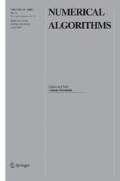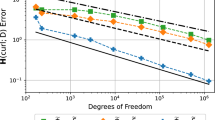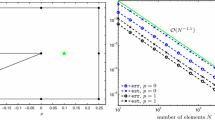Abstract
We present a new technique for generating error equi-distributing meshes that satisfy both local quasi-uniformity and a preset minimal mesh spacing. This is first done in the one-dimensional case by extending the Kautsky and Nichols method and then in the two-dimensional case by generalizing the tensor product methods to alternating curved line equi-distributions. With the new meshing approach, we have achieved better accuracy in approximation using interpolatory radial basis functions. Furthermore, improved accuracy in numerical results has been obtained when the interpolatory strategy is applied to the dual reciprocity boundary element method for solving a class of linear and nonhomogeneous partial differential equations.
Similar content being viewed by others
References
M. Ainsworth and T.J. Oden, A Posterior Error Estimation in Finite Element Analysis (Wiley, New York, 2000).
E. Alarcon and A. Reverter, P-adaptive boundary elements, Internat. J. Numer. Methods Engrg. 23 (1986) 801–829.
G. Beckett, J.A. Mackenzie, A. Ramage and D.M. Sloan, On the numerical solution of one-dimensional PDEs using adaptive methods based on equi-distribution, J. Comput. Phys. 167(2) (2001) 372–392.
W. Cao, W. Huang and R.D. Russell, A study of monitor functions for two-dimensional adaptive mesh generation, SIAM J. Sci. Comput. 20 (1999) 1978–1994.
G.F. Carey and H.T. Dinh, Grading functions and mesh redistribution, SIAM J. Numer. Anal. 22(5) (1985) 1028–1040.
K. Chen, Two-dimensional adaptive quadrilateral mesh generation, Comm. Numer. Meth. Engrg. 10 (1994) 815–825.
K. Chen, Error equi-distribution and mesh adaptation, SIAM J. Sci. Comput. 15(4) (1994) 798–818.
K. Chen, Improving the accuracy of DRBEM for convective PDEs, J. Engrg. Anal. Bound. Elem. 23 (1999) 639–644.
B. Jumarhon, S. Amini and K. Chen, On the convergence of the boundary element dual reciprocity method, J. Engrg. Anal. Bound. Elem. 20 (1997) 205–211.
B. Jumarhon, S. Amini and K. Chen, The Hermite collocation method using radial basis functions, J. Engrg. Anal. Bound. Elem. 24 (2000) 607–611.
J. Kautsky and N.K. Nichols, Equi-distributing meshes with constraints, SIAMJ. Sci. Statist. Comput. 1(4) (1980) 449–511.
P.W. Partridge, C.A Brebbia and L.C. Wrobel, The Dual Reciprocity Boundary Element Method (Computational Mechanics Publications, 1992).
V. Pereyra and E.G. Sewell, Mesh selection for discrete solution of boundary problems in ordinary differential equations, Numer. Math. 23 (1975) 261–268.
M.J.D. Powell, The Theory of Radial Basis Function Approximation in 1990, ed. W. Light, Advances in Numerical Analysis, Vol. II (Oxford Science, Oxford, UK, 1992).
A. Profit, K. Chen and S. Amini, Application of the DRBEMwith adaptive internal points to nonlinear dopant diffusion, in: Proc. of the 2nd UK BIE Conf. (Brunel Univ. Press, 1999).
W. Sun and N.G. Zamani, Adaptive mesh redistribution for the boundary element in elastostatics, Comput. Struct. 36(6) (1990) 1081–1088.
W. Sun and N.G. Zamani, Adaptive r and h–r algorithms boundary elements, Adv. Engrg. Software 15 (1992) 241–247.
W. Sun and N.G. Zamani, An adaptive h–r boundary element algorithm for the Laplace equation, Internat. J. Numer. Methods Engrg. 33 (1992) 537–552.
P.K. Sweby, Data-dependent grids, Numerical Analysis Report 7/87, University of Reading, UK (1987).
J.F. Thompson, U.A. Warsi and C.W. Mastin, Numerical Grid Generation Foundations and Applications (North-Holland, Amsterdam, 1985).
A.B. White, On selection of equi-distribution meshes for two-point boundary value problems, SIAM J. Numer. Anal. 19 (1979) 472–502.
S.P. Zhu, H.W. Liu and K. Chen, A general DRBEM model for wave refraction and diffraction, J. Engrg. Anal. Bound. Elem. 24 (2000) 377–390.
Author information
Authors and Affiliations
Corresponding author
Rights and permissions
About this article
Cite this article
Shanazari, K., Chen, K. A Minimal Distance Constrained Adaptive Mesh Algorithm with Application to the Dual Reciprocity Method. Numerical Algorithms 32, 275–286 (2003). https://doi.org/10.1023/A:1024027723984
Issue Date:
DOI: https://doi.org/10.1023/A:1024027723984




